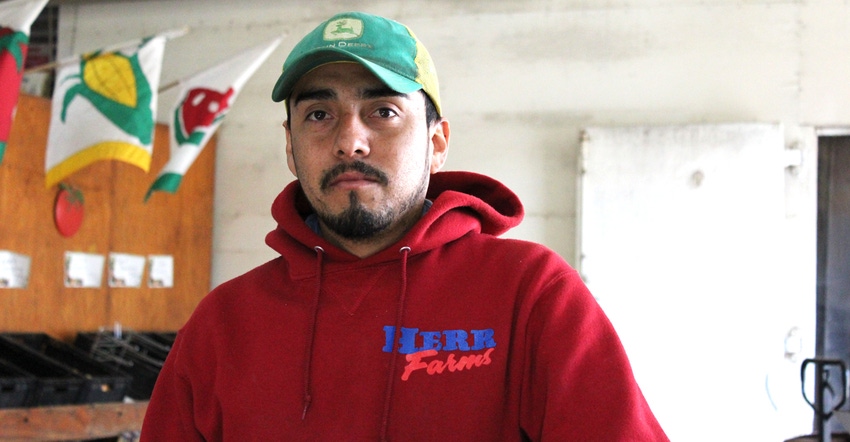January 21, 2019

By Myra Rademacher
For one Indiana farm family, Mexican laborers and other migrant farm workers are more than hired help; they are family.
“We depend on these guys,” says Carla Herr of Herr Farms near Lowell. “They work hard, and they’re the heart of our farm.”
Hiring foreign labor on farms can be a polarizing issue. But for Carla, the migrant employees hired to help the farm run successfully are the same people who have watched her sons grow up, teaching them how to play soccer and fly drones. She describes them as an extension of her family.
In Indiana, migrant labor is a critical part of many farms. Across the U.S., more than 60% of hired farm labor is of Latino origin, according to U.S. Census Bureau data.
Juan Sotelo is the head worker at Herr Farms, an American descendant of a migrant family. He lives near Lowell, where he is raising his two young boys with his wife. He graduated from Purdue Calumet, now Purdue University Northwest, in 2010, with the intention of working as a court interpreter. At one point, he was fluent in three languages.
Sotelo’s father worked on a farm not far from Herr Farms. He says his dad worked there for 35 years before the farmer retired and the Herr family began farming on his land. That was how Sotelo came into his current position on the farm, when he couldn’t find work related to his degree.
“The Herrs are nice people; they care about their workers,” he says. “It’s always a good feeling that someone else cares about you.”
Plenty of work
Carla and Jody Herr hire migrant workers to harvest vegetables and other crops from July through October. Through the Indiana Vegetable Growers Association, they found the temporary agricultural workers program known as H2A. This program allows agricultural employers to bring nonimmigrant foreign workers to the U.S. to perform ag labor or services of a temporary or seasonal nature, according to the U.S. Department of Labor.
One requirement of the H2A program is that employers must advertise domestically before they can hire foreign labor. The Herrs have advertisements in newspapers locally, in the Chicagoland area and in parts of Texas. So far, no one has applied for employment.
“There’s not enough local people to do the job,” Jody says. “We have had a few [applicants] in the past … but they didn’t have the knowledge of harvesting crops or packaging crops or anything that pertained to what we needed. Just like any other job, when you apply for it, you have to have some knowledge of what you’re doing.”
The National Agricultural Workers Survey reports that of all U.S. farm labor, 78% is foreign-born. Of that majority, 75% come from Mexico.
For Herr Farms, it has made sense for their business to hire international workers because they can’t find locals who are interested in working the harvest.
Carla has had men approach her who say, “Don’t you guys hire migrant labor? I can’t find a job and you’re paying the Mexicans?” She replies that the farm is looking for more workers, but she never receives work inquiries from the individuals who approach her.
Community issues
Many communities aren’t supportive of area farmworkers, even though they are a critical piece in the mechanics of farming, according to Kimber Nicoletti-Martinez, principal investigator and director of the Multicultural Efforts to end Sexual Assault program, or MESA, at Purdue University.
Nicoletti-Martinez, recipient of the 2018 National Social Worker of the Year Award, says many community members believe all Latino farmworkers are illegal or undocumented. However, in Indiana, many farmworkers are from the southern border of Texas or another region where Spanish is the primary language.
“The community may not understand how much the farmer really relies on having the farmworkers,” Nicoletti-Martinez says.
Migrant challenges
Along with discrimination due to their language or heritage, another challenge farmworkers face daily is limited access to resources. A prime example is a driver’s license: Most farms aren’t within reasonable walking distance of a town, and visa programs don’t provide a driver’s license to employees.
This means if an employee wants to buy groceries, cash a paycheck or economically engage with the local area, he or she must get a ride from someone with a car and a license, or find another way to go about normal activities with fewer resources.
“If you have people that have really limited resources … it really puts them at risk,” Nicoletti-Martinez says.
This increased risk carries over into other areas of a farmworker’s life. As temporary workers aren’t citizens, they don’t have access to health care, nor do they collect any Social Security money. Any emergency bills or associated costs are paid out of pocket.
Nicoletti-Martinez believes the greatest needs in farmworker communities are increased access to resources any employee would benefit from: access to mental health resources, education, economic empowerment, health care and affordable housing.
Herr Farms has hired workers through the H2A program for six years. The Herrs respect that the workers’ primary goal is to work, make money and provide for their families at home. It is a respectable mission that aligns culturally with a majority of working U.S. families.
“I couldn’t advertise in the paper or pay enough money to get people here to fill their positions,” Carla says. She knows that Sotelo and their seasonal workers understand that if they do well, the farm does well, and that means they do well, in turn.
Radamacher is a senior in agricultural communication at Purdue University. She writes from West Lafayette, Ind.
You May Also Like




